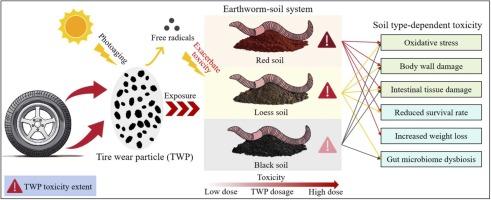Soil Heterogeneity Influences the Biotoxicity of Photoaged Tire Wear Particles in Eisenia fetida: A Comparative Assessment
IF 11.3
1区 环境科学与生态学
Q1 ENGINEERING, ENVIRONMENTAL
引用次数: 0
Abstract
Tire wear particles (TWPs) pose escalating environmental concerns owing to their aging-enhanced toxicity. However, the combined effects of photoaging and soil heterogeneity remain poorly understood. This study investigated the impact of virgin and photoaged TWPs on Eisenia fetida in three soil types (red, black, and loess), focusing on earthworm survival, weight loss, antioxidant responses, histopathological changes, and gut microbiota shifts. Results showed that photoaging significantly increased TWP toxicity, as evidenced by elevated surface environmentally persistent free radicals. High-dose exposure to photoaged TWPs caused the greatest reduction in earthworm survival (52.2% vs. control, P < 0.05) and the highest weight loss (0.113 g/worm, P < 0.05) in red soil, whereas the least toxicity (35.6% survival reduction vs. control, P > 0.05) was observed in black soil. The activities of antioxidant enzymes and reactive oxygen species levels were significantly higher in red and loess soils, indicating soil-dependent oxidative stress response. Histopathological analysis revealed tissue damage across all soil types, particularly with photoaged TWPs. Gut microbiota analysis revealed that earthworms in red soil exhibited the least intestinal microbial community shift with minimal diversity/structural changes. TWP exposure specifically increased inflammation-associated Proteobacteria and enriched pathogenic fungal genera. The fungal community response, which was positively correlated with earthworm weight loss (Mantel test, P < 0.05), could serve as a potential biomarker for TWP toxicity. These findings underscore the need for soil-specific risk assessments of TWPs in environmental management.

土壤异质性对光老化轮胎磨损颗粒生物毒性影响的比较研究
轮胎磨损颗粒(twp)由于其老化增强的毒性而引起日益严重的环境问题。然而,光老化和土壤异质性的综合效应仍然知之甚少。本研究研究了三种土壤类型(红、黑、黄土)中未处理和光处理的TWPs对肥Eisenia fetida的影响,重点研究了蚯蚓的存活、体重减轻、抗氧化反应、组织病理学变化和肠道微生物群的变化。结果表明,光老化显著增加TWP的毒性,表现为表面环境持久性自由基升高。高剂量暴露于光老化TWPs导致蚯蚓存活率最大程度下降(52.2%,P <;0.05),最大减重(0.113 g/只,P <;0.05),而毒性最小(比对照降低35.6%,P >;在黑土中观察到0.05)。红壤和黄土的抗氧化酶活性和活性氧水平显著高于黄壤,表现出土壤依赖性的氧化胁迫反应。组织病理学分析显示所有土壤类型的组织损伤,特别是光老化的twp。肠道菌群分析显示,红壤蚯蚓肠道菌群变化最小,多样性和结构变化最小。TWP暴露特别增加了与炎症相关的变形杆菌和丰富的致病真菌属。真菌群落反应与蚯蚓减重呈正相关(Mantel试验,P <;0.05),可作为TWP毒性的潜在生物标志物。这些发现强调了在环境管理中对twp进行特定土壤风险评估的必要性。
本文章由计算机程序翻译,如有差异,请以英文原文为准。
求助全文
约1分钟内获得全文
求助全文
来源期刊

Journal of Hazardous Materials
工程技术-工程:环境
CiteScore
25.40
自引率
5.90%
发文量
3059
审稿时长
58 days
期刊介绍:
The Journal of Hazardous Materials serves as a global platform for promoting cutting-edge research in the field of Environmental Science and Engineering. Our publication features a wide range of articles, including full-length research papers, review articles, and perspectives, with the aim of enhancing our understanding of the dangers and risks associated with various materials concerning public health and the environment. It is important to note that the term "environmental contaminants" refers specifically to substances that pose hazardous effects through contamination, while excluding those that do not have such impacts on the environment or human health. Moreover, we emphasize the distinction between wastes and hazardous materials in order to provide further clarity on the scope of the journal. We have a keen interest in exploring specific compounds and microbial agents that have adverse effects on the environment.
 求助内容:
求助内容: 应助结果提醒方式:
应助结果提醒方式:


